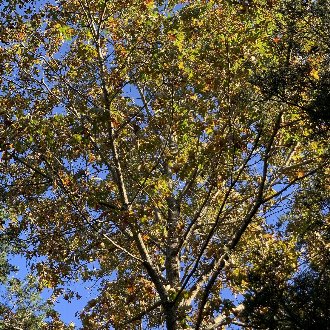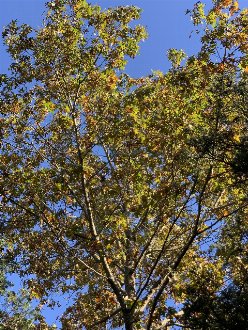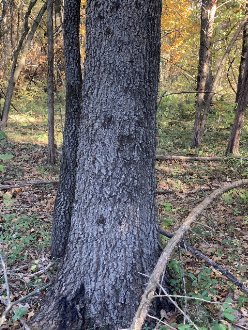Willdenow's Oak (Quercus ×willdenowiana (Dippel) Zabel)
↑Summary
A naturally-occurring hybrid of black oak (Quercus velutina) and southern red oak (Quercus falcata).
↑Description & Identification
This hybrid has more-or-less intermediate characteristics between its parents, but as its parent species look rather different from each other, it is less likely to be confused with them and more likely to be confused with cherrybark oak (Quercus pagoda), which looks superficially much more similar.
↑Habitat
This hybrid has been reported at various sites in 9 different states, spread over long distances, sparsely spanning most of the range of overlap of the two parent species. It may be able to occur anywhere in the region of overlap, but seems rare, although like most oak hybrids it is likely underreported due to difficulty of identification, which in this case is confounded by its close resemblance to cherrybark oak (Quercus pagoda), which is not one of its parents.
Its habitat preferences are not well known, due to the limited reports of its occurrence. We could not find any descriptions of these preferences in the literature. However, most oak hybrids tend to have habitat preferences intermediate between those of their parent species.
In this case, the parent species overlap in both preferring dry uplands, but also potentially occurring on well-drained sites in bottomlands. Neither are frequent on rich mesic sites. Both also prefer sandy, acidic soils, but can occur on other soil types including clay and loam. Q. velutina is more likely to occur on rocky soils whereas Q. falcata is more likely on silty soils and serpentine soils. Q. velutina is considerably more shade-tolerant than Q. falcata, and occupies later stages of forest succession, whereas Q. falcata considerably more heat-tolerant, so it is likely that this hybrid is intermediate in its tolerance of heat and shade. Q. velutina is more tolerant of fire.
Q. velutina is more of a habitat generalist whose presence is more a function of site history and opportunistic colonizaztion, than strong preferences, so this hybrid is likely more of a generalist than Q. falcata.
Based on these observations, this hybrid is probably most likely on uplands with dry, acidic, sandy to clayey soils, but it could probably occur on a wide range of other sites.
↑Links & External Resources
• Quercus ×willdenowiana (hybrid oak) | USDA PLANTS Database (About This Site)
• Quercus X willdenowiana | Biota of North America Project (BONAP) (About This Site)





